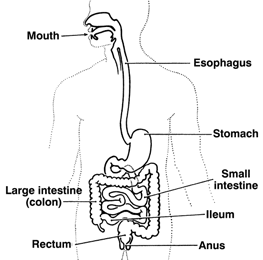

Intestinal Pseudo-Obstruction
On this page:
What is intestinal pseudo-obstruction?
Intestinal pseudo-obstruction is a rare condition with symptoms like those caused by a bowel obstruction, or blockage. But when the intestines are examined, no blockage is found. Instead, the symptoms are due to nerve or muscle problems that affect the movement of food, fluid, and air through the intestines.

The intestines, or bowel, include the small intestine and the large intestine, also called the colon.
Intestinal pseudo-obstruction can occur in people of any age, but it occurs more often in children and older adults. Children can have a long-lasting form of the condition called chronic intestinal pseudo-obstruction (CIP). CIP in children is usually present at birth.
In another form of intestinal pseudo-obstruction that mostly affects older adults, the colon becomes enlarged after surgery or illness. This condition is known as acute colonic pseudo-obstruction (ACPO), also called Ogilvie syndrome or acute colonic ileus. ACPO can lead to serious complications and can be life-threatening.
[Top]
What causes intestinal pseudo-obstruction?
Normally, nerves and muscles work together to produce wavelike contractions that push food through the intestines. In intestinal pseudo-obstruction, nerve or muscle problems prevent normal contractions. As a result, people with the condition have problems with the movement of food, fluid, and air through the intestines.
When the cause of the nerve or muscle problems leading to intestinal pseudo-obstruction is not known, the condition is called primary or idiopathic intestinal pseudo-obstruction. If the cause is known, the condition is called secondary intestinal pseudo-obstruction. Causes of secondary intestinal pseudo-obstruction include
- abdominal or pelvic surgery
- diseases that affect muscles and nerves, such as lupus erythematosus, scleroderma, and Parkinson’s disease
- infections
- medications such as opiates and antidepressants that affect muscles and nerves
[Top]
What are the symptoms of intestinal pseudo-obstruction?
Intestinal pseudo-obstruction symptoms may include cramps, abdominal pain, nausea, vomiting, bloating, and constipation. Occasionally, intestinal pseudo-obstruction may cause diarrhea. Over time, the condition can cause bacterial infections, malnutrition, weight loss, and muscle problems in other parts of the body. Some people develop problems with their esophagus, stomach, or bladder.
[Top]
How is intestinal pseudo-obstruction diagnosed?
To diagnose intestinal pseudo-obstruction, the doctor will take a complete medical history, do a physical exam, and take x rays. The doctor will make sure that symptoms are not due to an intestinal blockage and will look for the cause of the condition, such as an underlying illness. Other testing may be needed, such as manometry to measure the patterns of intestinal contractions.
[Top]
How is intestinal pseudo-obstruction treated?
People with intestinal pseudo-obstruction often need nutritional support to prevent malnutrition and weight loss. Enteral nutrition provides liquid food through a feeding tube inserted through the nose into the stomach or placed directly into the stomach or small intestine. Some people need intravenous feeding, also called parenteral nutrition, which provides liquid food through a tube placed in a vein.
If intestinal pseudo-obstruction is caused by an illness or medication, the doctor will treat the underlying illness or stop the medication.
Treatment may include medications, such as antibiotics to treat bacterial infections, pain medication, and medication to treat intestinal muscle problems. People with ACPO may need procedures to remove gas from the bowel. In severe cases of intestinal pseudo-obstruction, surgery to remove part of the intestine or other intestinal surgery might be necessary.
[Top]
Points to Remember
- Intestinal pseudo-obstruction is a condition with symptoms like those caused by a bowel obstruction, or blockage. But when the intestines are examined, no blockage is found.
- Intestinal pseudo-obstruction is caused by nerve or muscle problems that prevent the intestines from contracting normally to move food, fluid, and air through the intestines.
- Symptoms may include cramps, abdominal pain, nausea, vomiting, bloating, constipation, and occasionally diarrhea.
- Treatment depends on the type and severity of intestinal pseudo-obstruction and may involve nutritional support, medications, surgery, or other procedures.
[Top]
Hope through Research
The National Institute of Diabetes and Digestive and Kidney Diseases conducts and supports research to help people with digestive diseases. A complete listing of clinical research studies can be found at www.ClinicalTrials.gov.
[Top]
For More Information
Association of Gastrointestinal Motility Disorders, Inc.
(formerly American Society of Adults with Pseudo-Obstruction, Inc.)
AGMD International Corporate Headquarters
12 Roberts Drive
Bedford, MA 01730
Phone: 781–275–1300
Fax: 781–275–1304
Email: digestive.motility@gmail.com
Internet: www.agmd-gimotility.org
International Foundation for Functional Gastrointestinal Disorders, Inc.
P.O. Box 170864
Milwaukee, WI 53217–8076
Phone: 1–888–964–2001 or 414–964–1799
Fax: 414–964–7176
Email: iffgd@iffgd.org
Internet: www.iffgd.org
National Digestive Diseases Information Clearinghouse
2 Information Way
Bethesda, MD 20892–3570
Phone: 1–800–891–5389
Fax: 703–738–4929
Email: nddic@info.niddk.nih.gov
Internet: www.digestive.niddk.nih.gov
The National Digestive Diseases Information Clearinghouse collects resource information about digestive diseases for the National Institute of Diabetes and Digestive and Kidney Diseases (NIDDK) Reference Collection. This database provides titles, abstracts, and availability information for health information and health education resources. The NIDDK Reference Collection is a service of the National Institutes of Health.
You may view the results of the automatic search on intestinal pseudo-obstruction.
If you wish to perform your own search of the database, you may access and search the NIDDK Reference Collection database online.
This publication may contain information about medications used to treat a health condition. When this publication was prepared, the NIDDK included the most current information available. Occasionally, new information about medication is released. For updates or for questions about any medications, please contact the U.S. Food and Drug Administration at 1–888–INFO–FDA (463–6332), a toll-free call, or visit their website at www.fda.gov. Consult your doctor for more information.
[Top]
National Digestive Diseases Information Clearinghouse
2 Information Way
Bethesda, MD 20892–3570
Phone: 1–800–891–5389
TTY: 1–866–569–1162
Fax: 703–738–4929
Email: nddic@info.niddk.nih.gov
Internet: www.digestive.niddk.nih.gov
The National Digestive Diseases Information Clearinghouse (NDDIC) is a service of the National Institute of Diabetes and Digestive and Kidney Diseases (NIDDK). The NIDDK is part of the National Institutes of Health of the U.S. Department of Health and Human Services. Established in 1980, the Clearinghouse provides information about digestive diseases to people with digestive disorders and to their families, health care professionals, and the public. The NDDIC answers inquiries, develops and distributes publications, and works closely with professional and patient organizations and Government agencies to coordinate resources about digestive diseases.
Publications produced by the Clearinghouse are carefully reviewed by both NIDDK scientists and outside experts. This publication was reviewed by
Henry P. Parkman, M.D., Temple University School of Medicine.
This publication is not copyrighted. The Clearinghouse encourages users of this publication to duplicate and distribute as many copies as desired.
NIH Publication No. 08–4550
January 2008
[Top]
|




